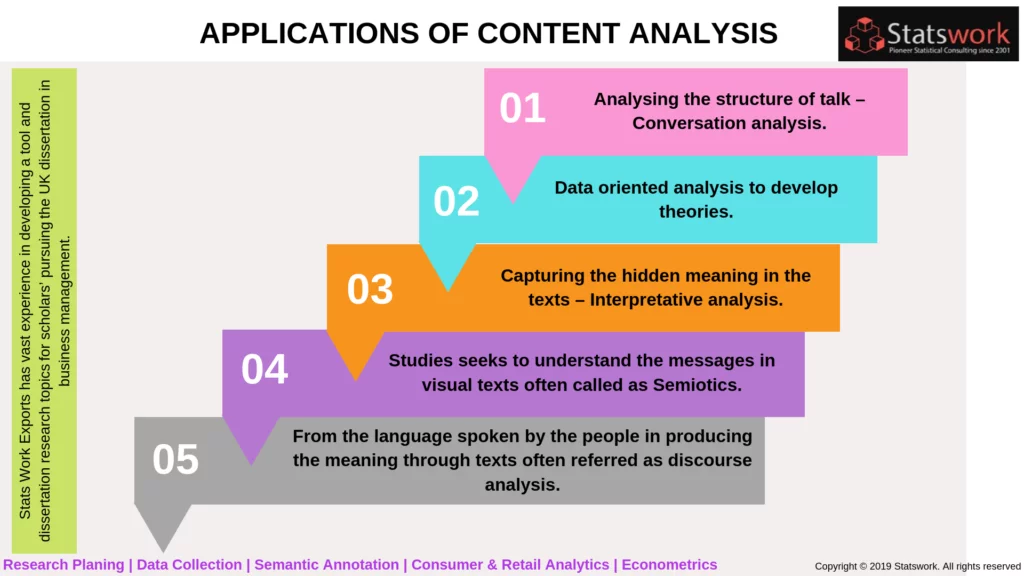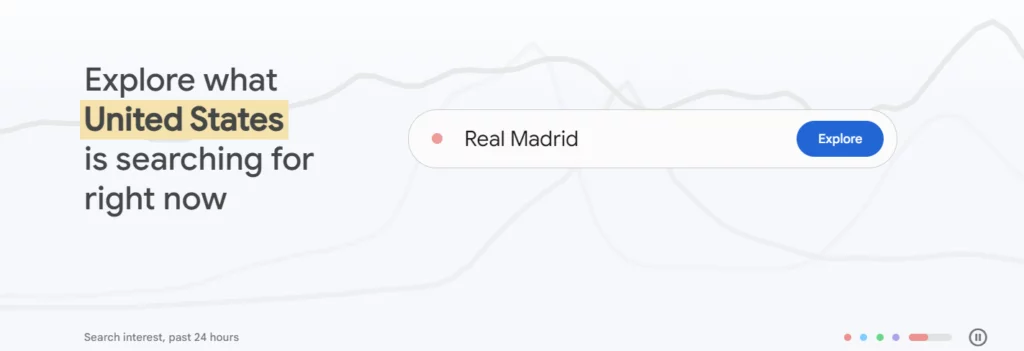Content analysis is an invaluable tool for both content marketing veterans and newcomers. For those already established, it offers a streamlined approach to identifying areas for improvement within your existing content library. For those just starting out, content analysis tools can provide powerful insights to kickstart your strategy without the need for a time-consuming manual review.

Benefits of Content Analysis Tools:
- SEO Optimization: Some tools specialize in identifying technical SEO issues, like keyword usage and page structure. This ensures your content ranks high in search results, driving organic traffic.
- Content Quality Enhancement: Go beyond SEO! Many tools comprehensively analyze content readability, clarity, and overall user engagement. This helps you refine your writing style and craft content that resonates with your audience.
- Data-Driven Decisions: Ditch the guesswork! Content analysis tools provide valuable data on performance metrics, like time spent on the page or bounce rate. These insights guide future content creation efforts for maximum impact.
- Efficiency Boost: These tools can analyze vast amounts of content in a fraction of the time it would take manually. This frees up your valuable time to focus on creating high-quality content.
- Competitive Advantage: Gain valuable insights into your competitors’ content strategies. This empowers you to create unique and differentiated content that stands out.
Top Content Analaysis Tools of 2024:
1. Hemingway App: Your Free Editing Sanctuary

Imagine having a seasoned editor whispering suggestions in your ear. Hemingway App does just that, offering a free platform for in-depth analysis of your writing. Paste existing content or write directly within the editor, and Hemingway breaks it down sentence-by-sentence.
Key Features:
- Clarity Champion: Hemingway highlights complex sentences with color codes, urging you to break them down for better readability.
- Readability Ruler: It unveils the reading level of your content, ensuring it caters to your target audience’s comfort level. This is especially valuable for creating accessible content for a wider readership.
- Conciseness Coach: Hemingway identifies passive voice and adverbs, nudging you towards a more active and concise writing style.
Benefits:
- Effortless Improvement: Receive insightful feedback on your writing clarity and structure, all for free.
- Enhanced Readability: Craft content that’s easy to understand and navigate, keeping your audience engaged.
- Inclusive Content Creation: Cater to a broader audience by ensuring your content’s reading level matches your target demographic.
2. Grammarly: Your Grammar Guardian Across Devices

Grammarly transcends basic spellcheck, acting as a comprehensive grammar and style guide at your fingertips. This versatile tool integrates seamlessly across various platforms, ensuring your writing shines everywhere – from emails to social media posts and website content.
Key Features:
- Grammar Guru: Say goodbye to typos and grammatical errors. Grammarly meticulously checks your writing for mistakes, ensuring polished and professional content.
- Style Savvy: Elevate your writing style with suggestions on tone, vocabulary usage, and sentence structure.
- Brand Consistency Champion: Grammarly offers enterprise features that allow you to create a custom style guide. This ensures all your content creators adhere to consistent brand voice and tone across platforms.
Benefits:
- Error-Free Content: Eliminate grammatical errors and typos that can detract from your professionalism.
- Elevated Writing Style: Craft content that showcases your brand’s unique voice and resonates with your audience.
- Streamlined Collaboration: Ensure consistent brand messaging across all content creators with custom style guides.
Learn about CMS here.
3. ChatGPT: Your Creative Brainstorming Buddy

ChatGPT isn’t just about grammar checks; it can be a valuable partner in the content ideation and brainstorming process. Think of it as a creative spark plug, igniting new approaches to your content strategy.
Key Features:
- Idea Alchemist: Stuck on a topic or blog post outline? ChatGPT can help you generate ideas, explore related themes, and identify connections within your content strategy.
- Content Simplifier: Do you have complex topics that need clear explanations? Leverage ChatGPT to break down the information into easy-to-understand language, making your content accessible to a wider audience.
- Grammar and Tone Assistant: Use ChatGPT to identify areas for improvement in your writing, like grammar issues or inconsistencies in tone and style.
4. Google Trends – Unlocking Data-Driven Content Strategies

In the dynamic world of content creation, understanding your audience’s needs is paramount. Google Trends emerges as an invaluable tool, offering a treasure trove of search data to fuel data-driven content strategies. Here’s a breakdown of its key features and benefits:
Key Features:
- Trend Discovery: Uncover what’s capturing your audience’s attention right now. Google Trends offers real-time snapshots of search popularity across various timeframes and geographic regions.
- Topic Exploration: Delve deeper into trending topics by exploring related searches and queries. This empowers you to create content that addresses the main trend and caters to its various subtopics and nuances.
- Comparative Analysis: Compare search volume for different keywords and topics side-by-side. This allows you to identify the most relevant themes and tailor your content accordingly.
Benefits:
- Content Relevance: Craft content that resonates with the audience’s current needs and interests, ensuring it remains fresh and engaging.
- Content Optimization: Leverage search data to optimize existing content and identify areas for improvement. This could involve including relevant keywords or aligning content with emerging trends.
- Informed Content Creation: Make data-driven decisions about your content strategy. Google Trends helps you identify topics with high search volume, allowing you to create content which has the potential to attract a wider audience.
- Content Repurposing: Revisit and refine your French press content to include relevant information about cold brew, potentially attracting a wider audience.
- Content Expansion: Capitalize on the search trend for a cold brew by crafting a dedicated page, expanding your content library, and catering to a broader range of search queries.
5. Yoast SEO: Streamlining On-Page Optimization for Free

Yoast SEO isn’t just a plugin; it’s a free content analysis powerhouse specifically designed for WordPress users.
Key Features:
- Title & Meta Description Optimization: Craft compelling titles and descriptions that precisely reflect your content and entice clicks in search results.
- Readability Analysis: Ensure your content is clear, concise, and easy for the target audience to understand. Yoast provides insights on sentence length, Flesch-Kincaid reading ease score, and suggestions for improvement.
- Internal Linking Assistant: Yoast identifies opportunities to link your content to other relevant pages, improving user navigation and website structure for SEO.
- Schema Markup Integration: Simplify the process of adding schema markup, providing search engines with richer context about your content for potentially improved search results.
- Focus Keyword Optimization: Optimize your content for a primary keyword, analyze keyword density, and suggest relevant LSI keywords for broader reach.
Benefits:
- Effortless On-Page SEO: Yoast streamlines technical SEO tasks, allowing you to focus on creating high-quality content.
- Improved Search Rankings: Yoast helps your content rank higher in search engine results pages (SERPs) by optimizing titles, meta descriptions, and keywords.
- Enhanced User Experience: Readability analysis and internal linking suggestions ensure your content is clear, engaging, and easy to navigate for users.
- Time-Saving Efficiency: Yoast automates many on-page SEO tasks, saving you valuable time and effort.
6. Frase: The AI-Powered Content Creation Engine
- Price: Starting at $14.99/month (individual plans)

Dyno is a relatively new entrant in the content analysis and optimization market, leveraging advanced AI to help content creators and marketers enhance the quality and performance of their textual content. The company focuses on providing tools that improve SEO, readability, and engagement, making it easier for users to produce high-quality content.
Key Features:
- Content Ideation & Outlining: Say goodbye to writer’s block. Frase leverages AI to analyze competitor content and search engine results pages (SERPs), generating content briefs, outlines, and writing suggestions. This streamlines your workflow and ensures your content addresses key topics and user intent.
- Content Optimization & Competitor Insights: Uncover content gaps and opportunities to optimize your existing content for higher search rankings.
- Data-Driven Content Strategy: Make informed content decisions based on competitor analysis and search engine insights.
Benefits:
- Effortless Content Creation: Save time and resources by using AI to brainstorm ideas, build outlines, and craft compelling content.
- Superior Content Quality & Relevance: Create data-driven content that addresses user needs and ranks higher in search results.
- Smarter Content Strategy: Develop content informed by competitor analysis and search engine trends.
7. DYNO Mapper: Your Content Strategy Roadmap
- Price: Starting at $39/month

Frase is a leading content analysis and optimization platform that uses artificial intelligence to help content creators produce high-quality, SEO-optimized content. Frase excels in generating content briefs, answering user questions, and providing real-time content suggestions, making it a favorite among content strategists and SEO professionals.
Key Features:
- Content Inventory & Audit: Gain a comprehensive overview of your website’s content. DYNO Mapper helps you categorize, analyze, and identify content gaps within your content strategy, ensuring you’re not missing crucial topics.
- Goal-Oriented Content Planning: Set clear goals for your content and plan its development using DYNO Mapper’s visual content mapping tools. This ensures your content aligns with your overall marketing objectives.
- Daily Keyword Tracking & Prioritization: Monitor your website’s ranking for relevant keywords daily. DYNO Mapper provides insights into keyword performance and identifies opportunities for improvement. It also helps you prioritize content creation tasks based on ranking potential and content gaps.4
Benefits:
- Strategic Content Development: Develop a data-driven content strategy that aligns with the business goals and target audience.
- Content Gap Identification: Uncover areas where you need more content and prioritize content creation efforts effectively.
- Improved Content ROI: Focus your resources on creating content that has the highest potential for driving website traffic and conversions.
Factors to Consider Before Choosing a Content Analysis Tool:
1. Purpose and Use Case
Before choosing a content analysis tool, clearly define your primary purpose and use case. Determine if you need the tool for academic research, market research, content creation, SEO optimization, or another specific task. Understanding the type of analysis you require, whether qualitative, quantitative, or a mix of both, will help you select a tool tailored to your needs.
2. Data Types and Formats Supported
Ensure that the content analysis tool supports the data types and formats you will be working with. If your analysis involves text documents, social media posts, or multimedia files like audio and video, verify that the tool can handle these formats. Additionally, check if the tool integrates smoothly with other data sources or platforms you use, such as CMS, CRM, or analytics tools.
3. Ease of Use
Consider the user interface and ease of use of the tool. An intuitive and user-friendly interface is crucial, especially if you or your team are new to content analysis tools. Assess the learning curve associated with the tool and the availability of training resources, tutorials, and customer support to ensure that you can effectively use the tool with minimal hassle.
4. Features and Functionalities
Evaluate the features and functionalities of the tool to ensure it meets your requirements. Key aspects to consider include coding and categorization capabilities, AI and machine learning features for automated insights, keyword suggestions, content scoring, and visualization options like charts and graphs. Additionally, determine if the tool supports collaborative work, allowing multiple users to work on the same project simultaneously.
5. SEO and Content Optimization
If SEO and content optimization are important for your work, look for tools that offer robust features in these areas. Check for keyword analysis capabilities, competitive analysis features, and tools for improving readability and tone. The ability to suggest relevant keywords, analyze keyword density, and provide insights into competitors’ content can significantly enhance your content’s search engine performance.
6. Integration and Compatibility
Verify that the content analysis tool integrates well with your existing software systems and workflows. Check for compatibility with platforms like WordPress, Google Analytics, and other CMS or analytics tools you use. Additionally, ensure the tool offers flexible export options, allowing you to export data and reports in various formats for further analysis or sharing.
7. Cost and Budget
Consider the pricing model of the tool and whether it fits within your budget. Content analysis tools may have different pricing structures, such as subscription-based, one-time purchase, or freemium models. Evaluate the value for money by comparing the features offered relative to the cost. Ensure that more expensive tools provide significant advantages in terms of functionalities and support.
8. Support and Training
Assess the quality and availability of customer support and training resources. Reliable customer support through channels like email, chat, or phone is essential for resolving issues promptly. Look for comprehensive documentation, tutorials, and training resources to help you get started and troubleshoot any problems that arise while using the tool.
9. Scalability and Performance
Check the tool’s ability to handle large volumes of data efficiently and its scalability to meet your growing needs. Ensure that the tool can manage extensive datasets without performance issues. Consider whether the tool can scale with your projects as they increase in size and complexity, providing consistent performance and reliability.
10. User Reviews and Reputation
Read user reviews and testimonials to gauge the tool’s effectiveness and reliability. Consider the reputation of the tool in the industry and its track record of updates and improvements. User feedback can provide valuable insights into the tool’s strengths and weaknesses, helping you make an informed decision based on real-world experiences.
Conclusion:
Content analysis tools play a crucial role in enhancing the quality, relevance, and performance of textual content across various domains such as marketing, research, and journalism. Selecting the right tool depends on your specific requirements, data types, and desired outcomes, but integrating these tools into your workflow can significantly improve content creation, optimization, and overall effectiveness.
FAQs on Content Analysis Tools:
What types of data can content analysis tools handle?
Most content analysis tools can handle a variety of data types, including text (documents, articles), audio, video, and social media content. Some tools are specifically designed for qualitative data, while others also support quantitative analysis.
How much do content analysis tools typically cost?
Costs vary widely depending on the tool and its features. Some tools offer free versions with limited capabilities, while others may require a subscription or one-time purchase fee. It’s important to evaluate the pricing against your budget and the tool’s offerings.
Can these tools be used for team collaboration?
Many content analysis tools support team collaboration by offering features like shared workspaces, real-time collaboration, and role-based access control, making it easier for teams to work together on large projects.
Can content analysis tools help with SEO?
Yes, many content analysis tools, like Dyno and Frase, offer SEO optimization features. These include keyword suggestions, content scoring based on SEO criteria, competitive analysis, and integration with search engine algorithms to improve content visibility and ranking.



